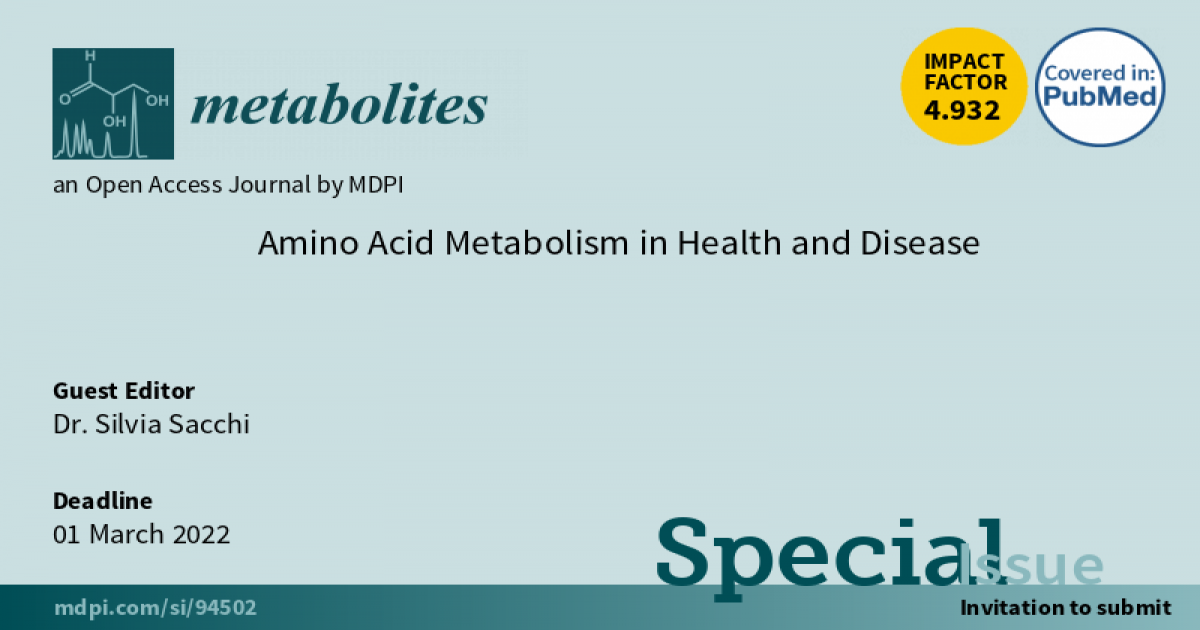- 3.7Impact Factor
- 6.9CiteScore
- 15 daysTime to First Decision
Amino Acid Metabolism in Health and Disease
This special issue belongs to the section “Endocrinology and Clinical Metabolic Research“.
Special Issue Information
Dear Colleagues,
Amino acids are not only the building blocks of proteins; they also act as intermediate metabolites fueling different biosynthetic pathways, and some function as or are synthesized into important molecules such as neurotransmitters, hormones, pigments, and oxygen-carrying molecules. Thus, plasma and intracellular amino acid availability and homeostasis are crucial and require a coordinated metabolism of synthetic, catabolic, and transport pathways. Accordingly, amino acid-related metabolic disorders comprise a very heterogeneous group of diseases, whose severity may range from mild to highly disabling illness, brain damage, or multi-organ involvement.
In this Special Issue, we aim to provide new insights into amino acid metabolism in health and disease, with an in-depth look also at D-amino acids and their role in brain “functioning and dysfunctioning”. We hope that the addressed topic will lead to a better understanding of the diverse mechanisms acting in the regulation of amino acid metabolism as well as further research studies aimed at investigating metabolic dysfunctions and their role in pathologies.
Dr. Silvia Sacchi
Guest Editor
Manuscript Submission Information
Manuscripts should be submitted online at www.mdpi.com by registering and logging in to this website. Once you are registered, click here to go to the submission form. Manuscripts can be submitted until the deadline. All submissions that pass pre-check are peer-reviewed. Accepted papers will be published continuously in the journal (as soon as accepted) and will be listed together on the special issue website. Research articles, review articles as well as short communications are invited. For planned papers, a title and short abstract (about 250 words) can be sent to the Editorial Office for assessment.
Submitted manuscripts should not have been published previously, nor be under consideration for publication elsewhere (except conference proceedings papers). All manuscripts are thoroughly refereed through a single-blind peer-review process. A guide for authors and other relevant information for submission of manuscripts is available on the Instructions for Authors page. Metabolites is an international peer-reviewed open access monthly journal published by MDPI.
Please visit the Instructions for Authors page before submitting a manuscript. The Article Processing Charge (APC) for publication in this open access journal is 2700 CHF (Swiss Francs). Submitted papers should be well formatted and use good English. Authors may use MDPI's English editing service prior to publication or during author revisions.

Benefits of Publishing in a Special Issue
- Ease of navigation: Grouping papers by topic helps scholars navigate broad scope journals more efficiently.
- Greater discoverability: Special Issues support the reach and impact of scientific research. Articles in Special Issues are more discoverable and cited more frequently.
- Expansion of research network: Special Issues facilitate connections among authors, fostering scientific collaborations.
- External promotion: Articles in Special Issues are often promoted through the journal's social media, increasing their visibility.
- e-Book format: Special Issues with more than 10 articles can be published as dedicated e-books, ensuring wide and rapid dissemination.

